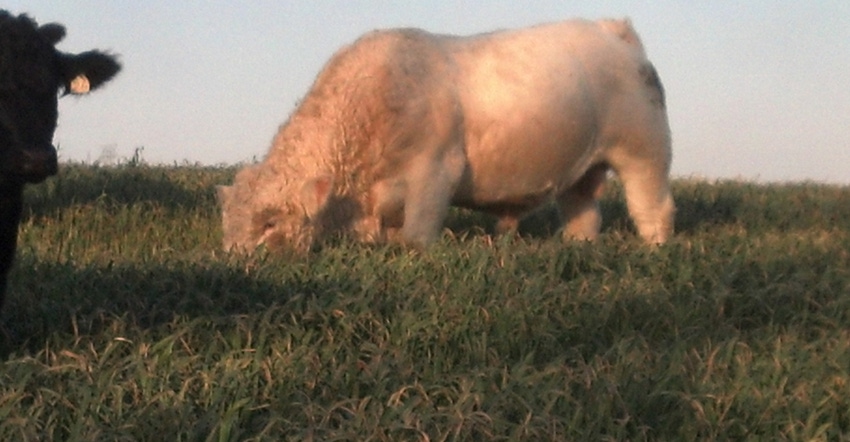February 28, 2017

By John F. Grimes
Bull buying season is well underway throughout the cow-calf regions across the country. Producers are constantly reminded of this through sale catalogs in the mail, glossy magazine advertisements and social media posts. These promotional efforts may make it seem like the Christmas shopping season has returned. Both of these “shopping seasons” can be equally confusing and frustrating for the buyer that is uninformed and unprepared.
As an Extension professional and a seedstock producer, one of the most interesting discussions I can have with a producer is reviewing their thoughts on what they are looking for in a potential purchase for a herd sire. Obviously, there is a wide range of criteria to be considered depending on the production goals and size of the herd. In my experience, two consistent themes emerge with discussions on a potential herd bull purchase: calving ease and price.
Expected progeny differences allow the breeder to identify the animals that excel in the traits that are important for their operation. EPDs can be used to determine exactly where herd sire candidates rank within a given breed and his potential to make significant improvements in performance of future calf crops. A documented health program should be emphasized with any herd additions regardless of gender. A sound biosecurity plan for the herd can go a long way to help avoid the introduction of a costly disease into a herd.
Any potential herd sire should complete a successful breeding soundness examination. This examination gives the purchaser an assurance that a herd sire candidate has the ability to get cows bred. Even mature bulls should have an examination performed prior to turnout before a breeding season. A cow is too expensive to maintain and feeder calves are too valuable to sell to take risks with poor potential reproductive performance from a sire without a fertility check.
Beef producers need to be concerned with a wide variety of production traits if they intend to be successful in this business. Weaning weights, yearling weights, milk, carcass traits, etc., should be prioritized to varying degrees depending on your marketing program. A person that sells feeder calves at weaning will be concerned about weaning weights, while a marketer of freezer beef will be more concerned about carcass traits. However, regardless of your marketing program, the traits of supreme importance are fertility (percentage of females bred) and calving ease (percentage of live calves).
While calving ease is extremely important, I believe there is a tendency for the typical Ohio herd owner to overemphasize calving ease across the entire herd. The average cow herd in Ohio numbers approximately 17 head, with most herds retaining some number of replacement heifers to add to the herd. Herds of this size usually work with one herd sire to cover both mature cows and yearling heifers. If you choose a herd sire with the proper calving ease for the heifers, he should also possess enough quality in the traits of importance, such as growth and carcass merit, for the mature cows. There are bulls out there that can do many things well, but they can be hard to find and more expensive to own.
It should be the goal of every cow-calf producer to purchase the best possible bull that fits within a determined budget. I realize that philosophy would result in a wide range of bull prices among producers. A rule of thumb that I have often heard for many years is that the value of a typical herd bull should be equal to the value of two to three market steers or four to five feeder calves at weaning. There are exceptions to these guidelines, but an above-average bull that excels for traits, such as calving ease, growth, carcass traits, etc., will likely demand a premium.
I am not about to tell any producer what the correct amount is that they should pay for a bull. I would like to offer a few suggestions for producers as they search for their next herd sire:
• Establish the production goals for your herd and select a sire that complements the needs of your cow herd.
• Use EPDs, actual performance data and selection indexes to identify outstanding sire prospects.
• Never buy a bull without a breeding soundness examination.
• Select the appropriate age and size that matches the number of cows to be bred. A time-honored rule of thumb is to place about the same number of cows or heifers with a young bull as his age is in months. Putting too many cows with too young of a bull is a recipe for open cows.
• A bull that can increase the number of live calves born, add growth and increase the maternal strength of a herd through daughters retained should be viewed as a sound investment.
• A low-cost bull that may not excel in traits of importance may be purchased just to get cows bred and does little to add to the profitability of the herd. This bull is little more than a “cow settler.”
Grimes is the Ohio State University Extension beef coordinator and a member of the OSU Extension Beef Team. The Beef Team publishes the weekly Ohio BEEF Cattle letter, which can be received via email or at beef.osu.edu.
You May Also Like




